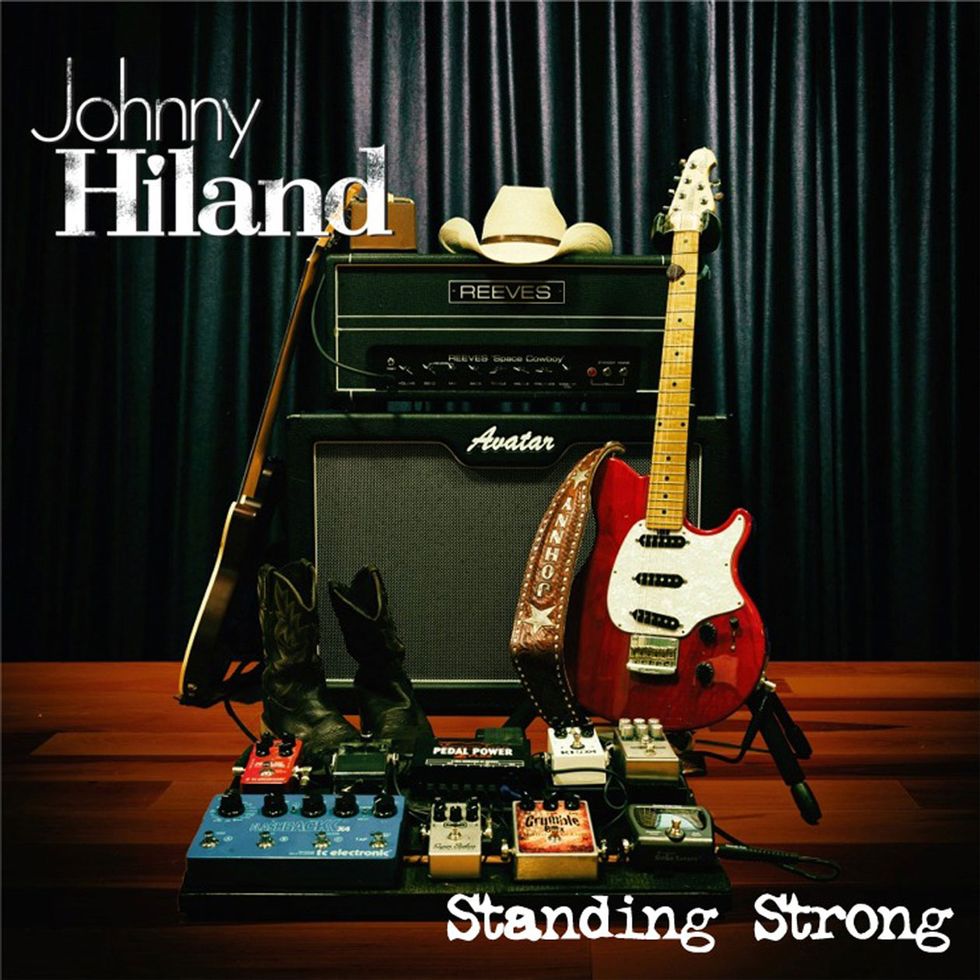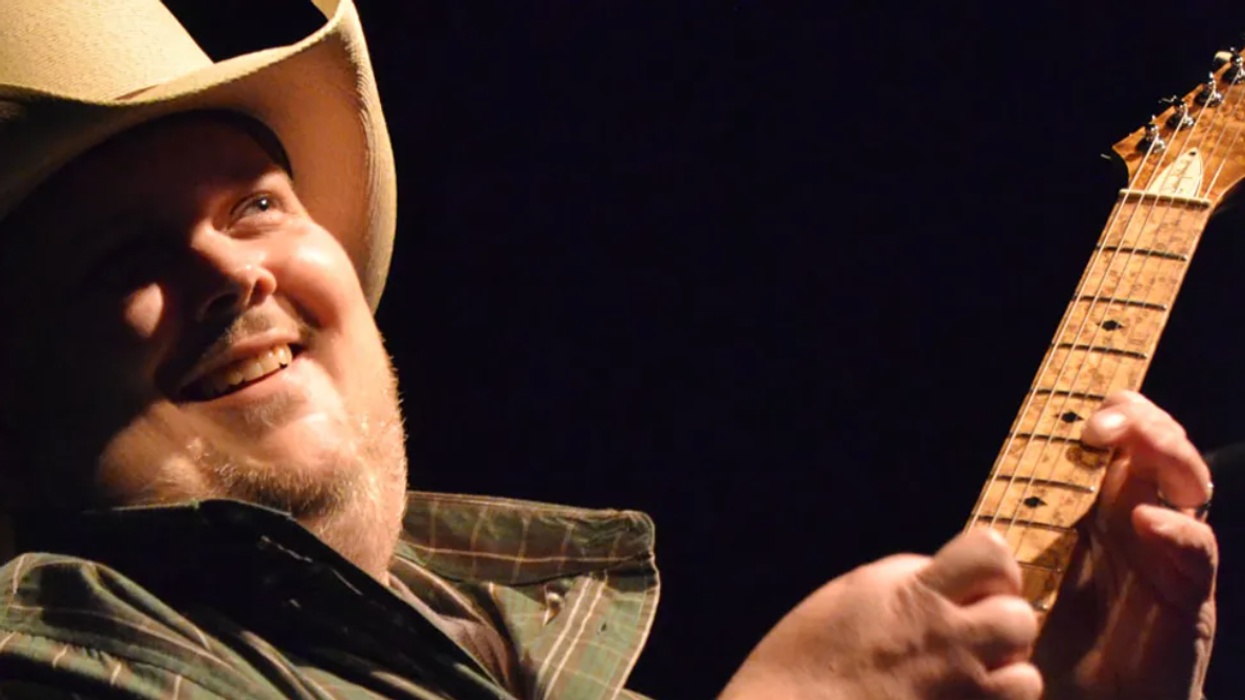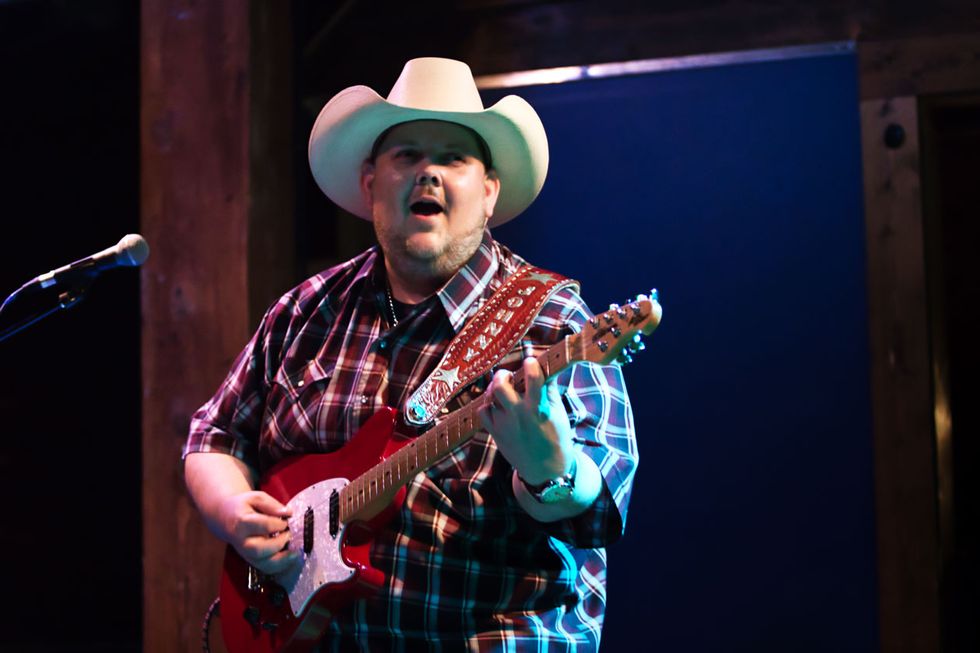There are guitarists who are creatures of habit, playing the same rigs for years or even entire careers, and then there are those who engage in ongoing searches for gear that will allow them to recreate the sounds they hear in their heads. Johnny Hiland, the electric-guitar virtuoso based in Nashville, falls squarely into the latter camp. He not only recently joined forces with Kiesel Custom Guitars to produce his dream axe, but in preparation for his latest album, Standing Strong, he gathered a boatload of new pedals to create a palette of inspiring sounds.
At 42, Hiland has been refining his signature approach—a spirited fusion of chicken pickin' and pyrotechnical rock moves—for decades now. Country music has always been at the heart of his playing. Hiland grew up in Maine, visually impaired through the condition nystagmus, and at 4 learned to play his late grandfather's Gibson J-45, tuned to an open-E chord, flat on his lap. Before long he had morphed into a bluegrass virtuoso, and he toured all over New England in his early teens.
A pivotal moment in Hiland's musical development came in the mid '80s, when his father took him to see Ricky Skaggs in concert. Witnessing Skaggs' mastery of the Fender Telecaster, Hiland was immediately drawn to the electric guitar. Then, Hiland got the rig, modest by his current standards, that would set him off on his tone quest: a Fender Standard Stratocaster, a Peavey Classic Chorus 212 combo amp, a Dunlop Cry Baby wah, and a DOD FX56 American Metal pedal.
While he was working out country-style bends on his Strat, Hiland learned from transcriptions of guitarists like Steve Vai and Joe Satriani, as well as blues greats like Stevie Ray Vaughan and Robben Ford. He knew then, as a teenager, that his music would be an amalgam of the hottest picking approaches in all styles.
He also knew that Nashville, Tennessee, would be the ideal home base, and in 1996 took residency in Music City and soon realized his dream of being an in-demand guitarist. Since then, he's worked as a sideman for high-profile country artists from Toby Keith to Hank Williams III. At the same time, beginning with a 2004 self-titled album for Steve Vai's Favored Nations label, Hiland has enjoyed success as a solo artist.
On Standing Strong, the follow-up to 2016's Loud and Proud, Hiland puts his new pedals to excellent use in his most song-oriented set to date. The album has plenty to recommend it to guitar fans of all persuasions, from serious chicken pickin' to killer slide work, and even two-handed tapping. In our recent conversation, Hiland had a lot to say about his pedals, the inner workings of his music, being in Nashville, and, of course, his new signature guitar.
Judging from Standing Strong, it sounds like lately you've been experimenting with your guitar tone while sticking to a lean ensemble.
Yes. And I would say that my basic tone—you know, the clean tone you hear on [the album's] “Freeborn Man" and “Honky Tonk Daddy"—is actually pretty much the same as the Johnny Hiland live sound. And I really spent a lot of time on this album making sure I didn't go over-the-top with extra instrumentation you wouldn't hear onstage, because I really didn't want to make a record I couldn't deliver to people at live shows. So we stuck to a four-piece configuration—bass, drums, rhythm guitar, and, of course, me on lead.
But some of the tones on the album were the result of me having lots of fun with pedals and sculpting the sounds I was searching for. Really, all my pedalboards were built based off just trying a bunch of things and finding what puts a smile on my face. So I guess that's what really made this album so special for me—I had time to try different tones and see what I really loved about what's out there nowadays, for effects.
How did you get that warm and gritty sound on “Long Road Home?"
I tried every distortion pedal I had and just wasn't quite getting what I wanted, so I literally went to Guitar Center and bought an MXR Super Badass after jamming with [former Allman Brother and legendary Nashville guitarist] Jack Pearson. I'd heard him get such a killer sound from an MXR at a live show, that I just had to get one for myself. The version I got is basically a heavier and more distorted version of what Jack was using, the Custom Badass. So I bought it, went into the studio, put it on my board, and that was the tone. It was like, “Oh, there it is. That's what I was missing."
Why do you think you hadn't found these sounds before?
I think what it is, man, is that sometimes the distortion pedals work really good with the compressor and sometimes they do not. Of course, I have different pedals for different levels of distortion, but I had literally tried everything in my arsenal. I was like the little kid with his box of toys. I just pulled out all these pedals and tried different things. But on that song, I realized I really needed that push over the edge of extra dirt, extra gain. And so the Super Badass was just something that really took it over the top for me. I should add that at that time, I had not tried the new Angry Charlie from JHS. I would say that the Super Badass and the Angry Charlie are comparable pedals because, while each one has such a unique voice, they're both very close in the gain stage. But that little Super Badass is not only an affordable pedal, but one that really makes you grin all over. It makes you play better.

“This new album is more vocal-based than anything I've ever done," says Hiland. “I thought it would be good to step out of my comfort zone and sing a little more."
How did you get the spacey sounds on the intro and transitional parts of the song?
These all had the DLS Versa Vibe on it, which is one of my favorite pedals as well. It's another pedal that people wouldn't think that I would ever use, but it has that Hendrix-y, squirrely sound that's so great. I added the DLS Versa Vibe for that extra something and it really gave me what I needed, man. Again, it put a smile on my face and was just what I was looking for.
What other modulation effects are you using now?
I love both the TC Electronics Flashback X4 and Hall of Fame dearly, and I'm also using the Helix Phaser by them. But I have other favorite pedals I just have to tell folks about. One is made by DLS, and it's called the RotoSIM. That's how I get my Danny Gatton kind of Leslie tones. That pedal is just phenomenal, buddy. It sounds as true to a Leslie as I've found yet. The next pedal is the DigiTech Mosaic—it's a 12-string simulator and I use it to get the sound of an electric Rickenbacker.
Is that what I hear on the intro to “Standing Strong?"
Yes, as a matter of fact. It sounds really realistic to me. And of course, when it comes to phasers and flangers and all the other fun stuff, man, I'm kind of all over the place. TC Electronic, DLS, and Big Joe—they all make those great pedals that just put a big grin on my face to use.
Compression plays a key role in hot country picking. What are you using for compression at the moment?
Right now I'm using an Origin Effects Cali76—the deluxe version, which is the new smaller edition they've come out with. People know that I love being a chicken picker and that I'm real hypersensitive about compressors. So to be honest, I have two others that are also my favorites right now—the JHS Pulp 'N' Peel and TC Electronic HyperGravity. And, of course, every board of mine includes an ISP Decimator II. I love that pedal, man. It's a must-have.
Why is that?
Well, because really when you're running any kind of a compressor and dirt pedal together, you're going to have excessive noise. The ISP Decimator II helps take out a lot of that unwanted noise, and it works really well.
For Hiland, playing guitar is about chasing new ideas and sounds. “Over the last 10 years or so, I've become more fluent in chromatics," he says. “I guess I'd have to give most of the credit for that to my love of Western swing." Photo by Andy Ellis
It sounds like you're prepared for any engagement with all those pedals.
Well, I'm 42 years old and I've been in this business a long time. I was always a guy who's just had the same pedalboard for years and stuck to what I knew worked for me. And to be honest with you, the technology has gotten so amazing these days that I just really wanted to have fun. I wanted to find some new inspiration. You know, I had so much fun checking out these new tools—it really opened my eyes to what technology was out there now. I'm truly amazed at how good effects have become. It was a revitalization, if you will, of my tone.
Let's talk about axes and how your preference in guitars has evolved.
It's funny, buddy, but I've spent a lot of time in my career trying to find the right Johnny Hiland sound. Of course, I started my career on a Fender Telecaster and a Twin, and then moved into the PRS world when I was working with Steve Vai and Favored Nations and jumped up on the stage with G3 and George Clinton and P-Funk—I needed more of the humbucker sound with 24 frets and a tremolo.
Eventually I wanted to go back to more of the Tele sound, but not play a standard Fender Telecaster, so I moved into the Music Man world. A lot of my fans have been begging me to go back to a Telecaster-style guitar, so I'm really excited about my new Kiesel Johnny Hiland signature model. It's basically a swamp ash Telecaster-style body with a maple neck, and it features my Electric City pickups—the Johnny Hiland Signature Six Shooter Singles. I'm really in love with the guitar, man. It's beautiful.
Tell us a bit about those pickups.
Billy Megela from Electric City Pickups designed these for me back in 2010 or '11. They're essentially based on a vintage Strat-style pickup. It's a set of three pickups—bridge, middle, and neck. But the bridge pickup, even though it's in a Strat form, has a base plate like a Tele, so it gives you a very snappy, twangy tone, and it's rated at 10.25k [DC resistance], so it's pretty hot. I'm a bridge pickup player, so that bridge pickup has to be spanky and twangy, man. The middle pickup, on the other hand, sounds very Strat-y, and the neck pickup has a real nice, round, bubbly, Jimi Hendrix-y kind of tone—but very warm and jazzy at the same time.
What is it about the Tele that feels like home?
I'm a guitar addict like anybody else, and I've loved a lot of different guitars in my life, but for the chicken-pickin' flare of what I do, a Telecaster-style guitar is so far up my alley. Nothing beats that tone, man, with that twang and that spank. And what Kiesel is doing nowadays—to really modernize the old-school Tele with a little more contour around where your forearm sits on the guitar, locking tuners, and medium-jumbo stainless-steel frets—is just right for me.
Getting back to the album, your love of shred guitar is apparent, especially on the opening track, “Long Road Home."
Well, I think it's no surprise to my fans that I love the sound of '80s rock guitar, because I put it in every show. And, of course, on all my albums, I've always had some kind of rock tune on there. It's really certainly a part of who I am as a player. I guess I've been around Steve Vai and Joe Satriani and guys like that enough to where it was unavoidable.
You do some killer tapping on the tune.
Thank you, buddy. Funny enough, the finger-tapping side of things really came in for me when I was trying to copy the steel guitar, and I would try to reach up with my finger and tap a note to get that steel sound. And obviously it also came from Van Halen and Steve Vai and Satriani and all those guys. I'm really still a big kid, and I love that side of music, even though it's not really at the forefront anymore … though it is in my house. I'm still constantly listening to and deeply influenced by players like them.
The song also feels quite emotionally resonant.
I think that tune really means a lot to me because it's about my family. I lost my mom and dad in '05 and '07. And living here in Nashville, it's really hard for me to get back to Maine, where I still have family. So I wrote “Long Road Home" thinking of how important it was for me to make sure I didn't lose touch with the rest of my family that's still around.
The tune also took me back to when I was first sending demos to Steve Vai, and I was creating my Favored Nations album. He would tell me stuff like, “Try to create a melody that is hummable and will stick in your head, so you can whistle it long after you hear it." And so, when I wrote the initial hook line for “Long Road Home," I was like, “Oh, there's a line right there and it's sticking in my head. So it might also stick in everybody else's."

Guitars
Kiesel Johnny Hiland signature model with Electric City Six Shooter Singles pickups Amps
Amps
Beteramp Johnny Hiland 100-watt head
Reeves Space Cowboy 100-watt head
Avatar Johnny Hiland Signature 4x12 cab (half open-back, half closed-back) with Celestion G12K-100 speakers
Effects
Origin Effects Cali76
TC Electronic HyperGravity
Carl Martin PlexiTone Single Channel
Carl Martin AC-Tone
MXR Super Badass Distortion
MXR M78 Custom Badass '78 Distortion
Big Joe Stomp Box Company B-408 Phaser
DigiTech Mosaic
DLS RotoSIM
DLS Effects Versa Vibe
TC Electronics Flashback X4
TC Electronic Hall of Fame Reverb
ISP Technologies Decimator II
Strings and Picks
Elixir Nanoweb, Polyweb, and Optiweb sets (.009–.042)
V-Picks Johnny Hiland signature model (2.75 mm)
Big Heart Custom Shop porcelain slides
Analysis Plus cables
And when I took it into the studio, I just wasn't finding the tone that I needed, but the Super Badass pedal and the DLS Versa Vibe really brought it forth for me. So I'm really proud of that track, man. It was wonderful to see something I've written with a memorable melody take on a life of its own in the studio. Even though I'm not an old man yet, I find I've changed over the years to where I really enjoy taking my time to find that proper tone. When “Long Road Home" was finished, I thought, “Yes, that's it. That's exactly what I wanted."
You play some superb slide lines on “Goin' Down to Memphis."
Oh, thank you, man. Well, I must say I'm a huge Sonny Landreth fan. I've had the sincere pleasure of doing a few shows with Sonny throughout the years, and he's always been so kind to me. I really love his style and his slide approach. But then again, I'm more of a slide player in standard tuning. I've never been the type of player to have an extra guitar tuned to open A or open G. I always wanted to have that freedom to just reach in my pocket, grab my slide, and go for it in standard tuning, so I worked really hard to become adept at being able to have that kind of freedom.
I knew right away that “Goin' Down to Memphis" needed that slide. You know, it's funny, this new album is more vocal-based than anything I've ever done. This time I really wanted to do vocal songs that were accentuated by the guitar. My buddy Ron Lutrick and my dear friends Rick and Justin Bowman helped me write a lot of songs on this album. Ronnie took part in “Going Down to Memphis," and as we wrote that song, the first thing that came to my mind was, “Oh, I get to pull out the slide and have some fun." So that's what we did.
You've called Nashville home for years. How has your musicianship evolved as a consequence of living there?
I really love Nashville and I always have. When I was 7 years old I wanted to move here and play the Grand Ole Opry, so I must say it's been a dream come true for me. But to answer your question, over the last 10 years or so, I've become more fluent in chromatics. To me melody now is not just what you'd find or hear in the major or pentatonic scales. I started branching off a little bit into more of a, not really a jazz head per se, but just more open territory in terms of melody. And I find I've opened up my vocabulary a lot by doing that. As a chicken picker, I guess I'd have to give most of the credit for that to my love of Western swing. And I just really love the openness of the chromatic feel, which has transformed my style in big ways.
What is it like to work with your writing team in Nashville?
Rick and Justin Bowman—they're father and son—are two dear friends of mine. I met Justin through the Make-A-Wish foundation. He had a kidney transplant when he was 17, and we got really close after meeting one another. I learned that he and his dad were great songwriters, and so our relationship grew naturally from being friends to penning tunes together.
In preparation for Standing Strong, we'd grab a Subway sandwich and catch a movie in the afternoon. If a song idea hit, we'd pause the movie and go, “Hey man, I like this line—check it out." And then one line would lead to another, and then the next thing you know, an hour later, you've got a song done.
Since 2008, we've written almost 500 songs together. But it was funny for me because I had never really done a vocal-based album, and I thought it would be good to step out of my comfort zone and sing a little more. So I just took some of my favorite tunes that Rick and Justin and I had written, mixed them with a few others—you know, with Ronnie Lutrick writing “Going Down to Memphis" with me. And then Rick and Justin and I put some finishing touches on that.
Then there were outside inspirations, as well. A dear friend, a guitar player buddy here in town, called me one day and we were talking about money issues and whatnot. He said, “You know man, hard times never last, but tough people always do." And I said, “Oh, I'm gonna steal that." We were just having a conversation, but I got this great song hook [for the song “Hard Times Never Last"] to run with. You always have to be ready to receive a great song idea from out of nowhere.
In this white-knuckle rendition of the Lynyrd Skynyrd classic featured on Standing Strong, Johnny Hiland displays his mastery of blazing chicken pickin', '80s power guitar, Southern rock, warp-speed Chuck Berry double-stops, pedal-steel bends, squealing harmonics, and more. YouTube Search Term: Johnny Hiland - “Call Me the Breeze" - Acme Feed & Seed/Nashville - July 14, 2017


















![Rig Rundown: Russian Circles’ Mike Sullivan [2025]](https://www.premierguitar.com/media-library/youtube.jpg?id=62303631&width=1245&height=700&quality=70&coordinates=0%2C0%2C0%2C0)








